 |
| Scientifically blonde. |
How does hair straightening work?
There are a few different procedures for hair straightening, and different types of hair are better suited to different ones. They all work on similar principles though, and it’s actually the same as for perming. It’s not too complex, and you should believe me on this one because Elle Woods agrees. So there. (The technical term for this sort of chemistry is called redox (pronounced “REE-docs”), which is a word you can use at parties to gain respect or be ostracised, depending on what sort of party you’re at.)*
Structure of hair
If you’ve ever looked at hair products, you’ll know that “protein” is thrown around a lot, which makes sense because hair is mainly made of a protein called keratin (nails are too). These keratin proteins contain lots of an amino acid called cysteine, which is special because it contains sulfur atoms (“S”). These sulfur atoms can make two bonds, and when exposed to oxygen in the air (aka “are oxidised”), they prefer to make bonds with other sulfurs like this:
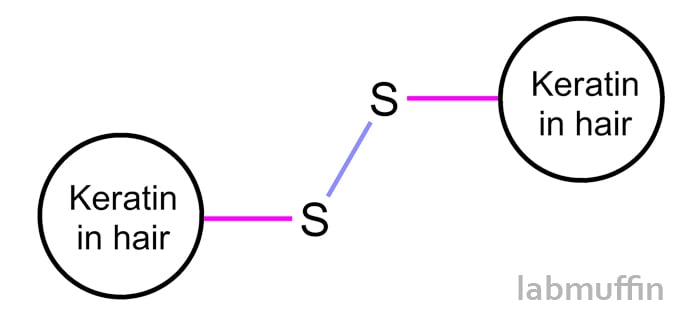 |
| Holding hands! |
So each keratin protein in a strand of hair is holding hands other keratin proteins in the same strand (every keratin has lots of little S atoms). All these little connections at a sub-microscopic level is what gives hair its shape, and also makes hair strong.**
Changing the structure
If you’ve managed to read this far, you might have already guessed how to change the shape of hair – break these little S-S (“disulfide”) connections, bend the hair into the new shape, and remake the S-S bonds! And that’s exactly the basis for how chemical straightening and perming works. You can break the S-S bonds (“reduce” the bonds) with a number of chemicals – examples are lye (sodium hydroxide), guanidine hydroxide and most commonly, sulfur-containing compounds such as ammonium thioglycolate (the chemical which Reese Witherspoon pronounces slightly wrong in Legally Blonde – it should be ah-MOAN-nee-um thigh-oh-GLYE-co-late).
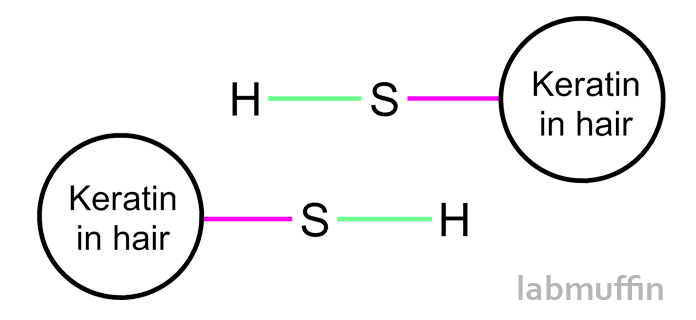 |
| Breakup time… |
At this stage, the hair is weak and pliable, and letting the solution sit for too long can even make the hair break off. You can bend the hair to the shape you want now (with rollers, or a straightener, or even by just letting it hang straight), then re-form the S-S bonds with a neutralising agent (usually a solution of sodium peroxide, or hair bleach – but obviously not so strong that it changes the hair colour). The new S-S bonds hold the hair in its new shape. Although many of the new shape-giving bonds are formed during the treatment, a lot of them aren’t yet remade. That’s why you’re advised against washing or tying up your hair for a day or so after the treatment – oxygen from the air will slowly finish making the remaining S-S bonds to give your hair its final shape.
My first experience with permanent chemical straightening
I’ve had a keratin treatment before (reviewed here), but while that tamed my hair a little and helped its condition, the straightening effect was gone in a few months. I’d been eyeing my sister’s good results with the Shiseido procedure she had done overseas, so I was very excited when I heard that Yuko were coming to Australia, and wanted guinea pigs to trial their straightening system! Yuko is a straightening system developed by the adorable-looking Yuko Yamashita, who is one of the hair experts featured on Sunsilk products you might’ve seen. It’s one of the original and most popular Japanese straightening systems, along with Shiseido and Bionic. From what I understand, the key distinguishing feature of Japanese straightening is that hot hair straighteners are used to reshape the hair – Yuko also uses ammonium thioglycolate and Phiten water, which is water with tiny particles of metal dispersed in it, although I’m not sure what it’s supposed to do. My treatment was carried out by John at Scissor Trix, a suburban hair salon in Western Sydney. The shopping centre has free 3 hour parking, hurray! Luckily, the treatment takes around 3 hours. The salon is very friendly and service isn’t rushed – very different from the busy salons I usually frequent in the CBD. First, my hair condition was assessed to pick the right straightening solution and work out how long it should be left on. John then shampooed my hair, added the slightly whiffy ammonium thioglycolate solution and let it do its thing (John checked the progress by stretching a few strands). The solution was washed out, then my hair was blow-dried, ironed, and neutralising solution was applied. A final rinse, blow dry and iron completed the job. (Also lots of protecting and nurturing solutions were sprayed onto my hair at various stages, which makes sense since ammonium thioglycolate also makes the hair shaft far more permeable to things which normally wouldn’t be able to penetrate.) After this, I can’t wash my hair, tuck it behind my ears or tie it up for 48 hours and then I was sent on my merry way, with a Yuko shampoo and conditioner which I’ll review properly later.
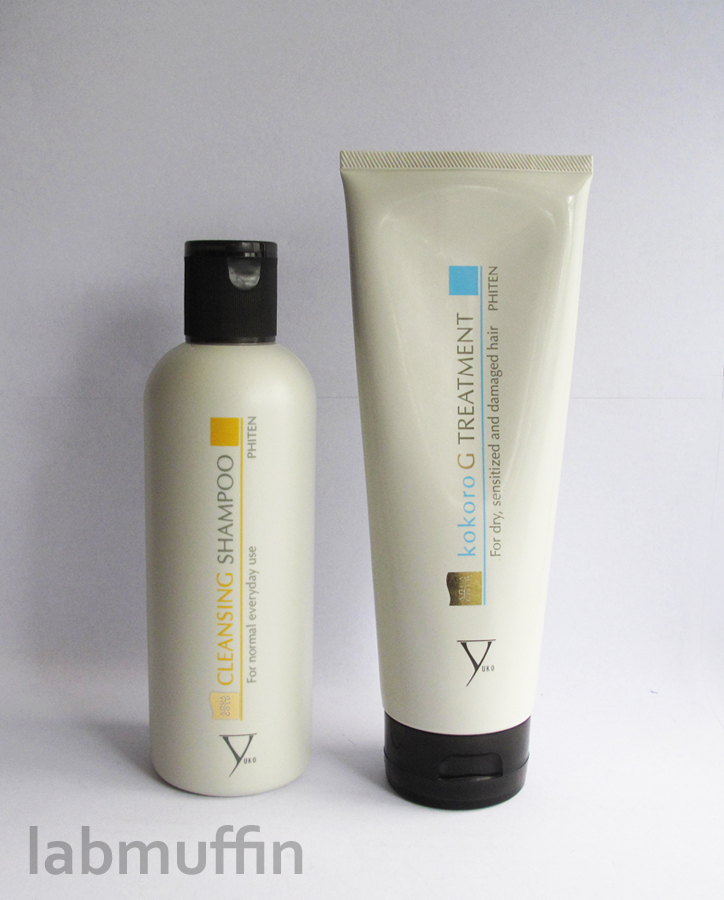 |
| These guys! |
So here’s my hair, both photos taken after letting it air dry then sleeping on it:
Overall, I’m really happy with the result, and I will definitely continue chemically straightening my hair in the future (until it falls out, that is). Although my hair was already moderately straight before the treatment, the biggest plus is that my hair is a lot less voluminous than in the past – I can actually wear it out without half of it bouncing onto my face, even without using a flat iron! After the treatment, my hair felt as strong and smooth (“healthy”) as before, which is apparently a feature of the Yuko treatment; however, since my hair is also coarse as hell and impossible to break, I can’t guarantee that will be the case for all hair. Although the treatment is expensive ($300-600 depending on hair length and the individual salon), the top of my hair is usually quite straight, so my treatment should last a while. If your hair is fine, damaged, curlier at the top or already quite straight, this might not be the treatment for you, and for long term straightening you might want to look into keratin treatments, or Yuko’s Anti-Frizz treatment (which appears to be something like a keratin treatment, without being a keratin treatment). For salons which offer the Yuko treatment (which is still in its very early stages of expansion in Australia), check here. * “Redox” is short for reduction + oxidation, which are the two steps involved in “unbonding” and “rebonding” the hair. ** Hair shape is also governed by weaker, more easily broken bonds called hydrogen bonds – these are what you break and remake when you wash your hair, use heat stylers, or walk around in high humidity air. I briefly touched on this in this post here. Yuko treatment and products were provided for editorial consideration, which did not affect my opinion. For more information, see Disclosure Policy.



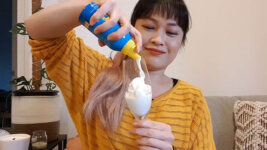
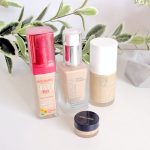
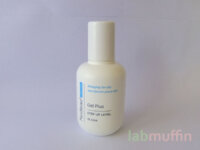
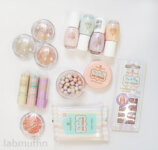
You have gorgeous hair, I like it wavy and straight!!
I’m having a giveaway for some hair products, please come over and check it out :o)
Jac x0x
matillysthisnthat.blogspot.com.au
Very cool to read! Thanks for the simple explanation and diagrams. Your hair looks very nice!
Interesting read and lovely hair either way!
Hi Michelle! I would be very curious to know what kind of treatments and when you received them during the treatment? Do you think using treatments like k18 or Olaplex during the treatment is a good idea? And what do you think about doing a Brazilian blowout right after to bring the treatment and shine effect?
this is very interesting!! great post 🙂
Really cool!
Love hair! Your post is really interesting!
good one !!
i appreciates the choice of words being used in this post and would like to add my experience being a user of the hair products. I too bought a hair straightener six months ago and its been awesome. I uses it on monthly basis.
IT service management is built around processes and practices to facilitate gauges,
Lab IT services OC is a nationally well-known leader in the forensic science population.
Laptop Chip Level Cervice Center in Lab computer Services Los Angeles Required Experienced Laptop Chip Level Engineers
We are Offering Excellent Work Progress and Attractive Salary
Lab IT services OC
Lab IT Services LA
Lab IT services Los Angeles
Lab IT services Orange County
Lab Computer services LA
Lab computer Services OC
Lab computer Services Orange County
Lab computer Services Los Angeles
Already i read many of the websites hair straightening is not good for our hair, i need some tips to How to Reduce Hair Fall
Of course it’s not good for your hair. But if done properly, I’m sure you’ll be fine. I’ve been having my hair permanently straightened for around 8 years. I have never had an issue. I’ve even lightened it without anything crazy happening (like my hair falling out).
Hi there,
I am wondering if you could help me with the answer based on chemistry knowledge you have regarding this chemical straightening:
I’ve done keratin treatments for years now (the one witching formaldehyde) and was very happy with result, my hair is fine and not coarse at all. By stupid accident (my fault for not speaking Spanish) I had chemical straightening done on my hair (it stripped the hair colour completely so hairdresser had to put it back straight after!), it flattened my hair on top. I got terrified of the look so didn’t wait for 3 days of ‘no washing’ and washed it 24hrs later.
Now (almost 2 months later) it feels terrible dry and very coarse to touch when under water washing it. It muddles up all the time as never before. It’s broken (bent at 90 degree angle) at the top where they flattened it, and the worst – I started loosing much more hair when before:(
So the question is really – have I screwed it up myself by washing earlier? Are you aware of any products to straighten the hair kink/bend that are not chemically harsh (organic keratin didn’t help though to straighter then kink on top). And also any products that stimulate hair growth that are scientifically proven?
Cheers, Yul
Unfortunately I don’t know much about the range of hair treatments available – perhaps look for a hairdresser with good reviews and go from there!
Is perming more or less damaging than dyeing and bleaching? Also, is it helpful to use Olaplex after a few days? Or do all the sulfides bond with the neutralizing lotion? Was shocked to read that the neutralizing agent is hair bleach by the way!
I can only speak from experience, so this is anecdotal. I have bleached my hair and I also get my hair permanently straightened. Bleaching has been way worse on my hair than straightening ( I used to bleach my hair, before I started getting it straightened. It was not a combination of the two). I know they work on a similar basis, but the bleaching caused way more unmanageable damage to my hair. I had to cut a lot of my hair off. The straightening is still damaging, just no where near the same damage as bleach. But, it’s important to go to a quality hair stylist also, who knows their stuff. Like Michelle explained here, my stylist also applies conditioning agents during the process. If she didn’t do that, maybe it would be worse. I can’t say. But definitely I do not have the extensive damage that I had from bleaching!
Great explanation, thanks! Could you also explain what ‘thio free’ perms are and why/if they are better? The words thio free seem to be used by a lot of brands …
I’ll have to look into them!
Just discovered your website. So many interesting articles!
I have been getting Yuko straightening for 17 years (it came to the US in 2002) and absolutely love it. I have extremely curly hair and get my roots touched up every 8 months or so.
I’d love to read more from you on this topic. Did you continue doing Yuko? Have you tried it with Olaplex?
Thank you for such an informative website!
Please can you tell me if hair rebonding create any waterproof layer on hair??